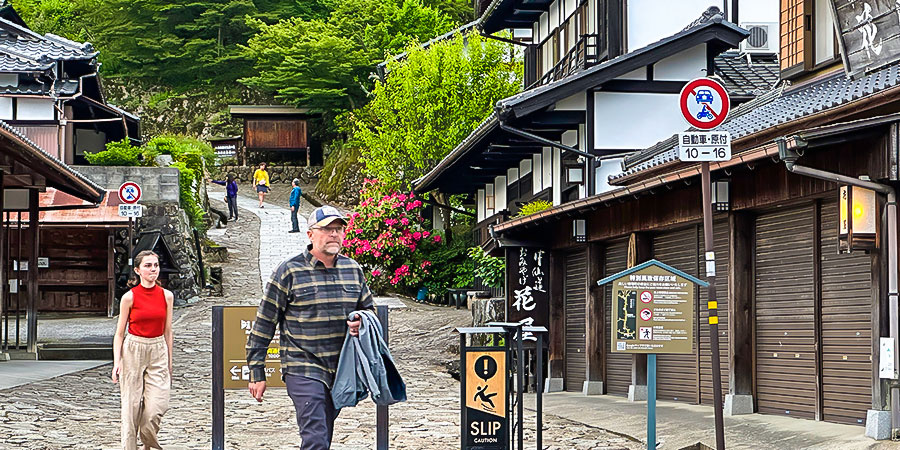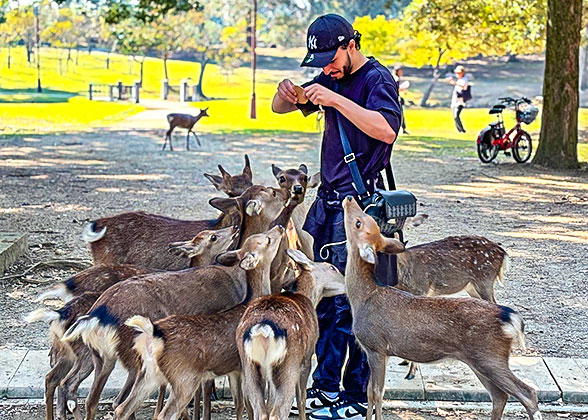Magome – The Most Visited Post Town on Nakasendo Way
As the No.43 shukuba (post town) on Nakasendo Way, Magome, at the southern entrance of Kiso Valley, has been a popular hiking destination in Japan. Starting from Magome, the section to Tusmago is the best part of Nakasendo Way for hiking. At the small post town, the stone-paved street, only 800-m (875-yard) long, is lined with stores of local specialties, cafés, small restaurants, inns, and so on retain the style in Edo Age (1603-1868 AD).

|
In those days, may people, like travelers, merchants, itinerant performers, etc., came and went by Magome all through the year. Nowadays, all these houses in old structure have been well preserved, and it seems that time stands still there. You may feel yourself traveling through time to the ancient period at this nostalgic town surrounded by mountains. It is also incomparably beautiful with rolling Enasan Mountain, setting sun and seasonal blossoms, deserving to be a perfect place for shutterbugs.
Magome is the name of this post town. Sometimes or somewhere, it is called as Magomejuku, too; as the postfix “-juku” just means a post town.
Highlights at Magome

|
What to See & Things to Do at Magome
Waki-honjin Historical Museum

Waki-honjin Historical Museum
|
At Magome, Waki-honjin Historical Museum is a must-visit. As the Waki-honjin there has been partially restored, you could get a glimpse of what it was like in the ancient time. Also, some historical relics are displayed and the local regimes in that period are introduced. It opens at 09:00-17:00 every day, requiring an admission ticket of JPY 300 per adult.
Kurumazaka Masugata (車坂)
Kurumazaka Masugata indicates the true entrance to the post town. It is actually a section of road that was constructed with right-angled bends, and is said to be a traditional defense work in Japan. Japanese call such a road as “枡形”. You could walk through the two right-angled stone-paved bends at Magome, to imagine that how they were built and how they played their roles in the past.

On the Kurumazaka Masugata Slope
|
Shimizuya Museum
It was the house of a family who had been the officials at Magome for generations, also the family kept a close relationship with the Shimazaki family. Books, hanging scrolls, and pictures from Toson Shimazaki are on display, meanwhile the collections include documents, paintings, calligraphy works, ceramics, and lacquerwares from the Edo Age that Magome was flourishing. The life and cultural history of Magome can be learned there completely.Its opening hours is 08:00-17:00 in most months, while it changes into 08:30-16:30 during December-March. An adult admission ticket costs JPY 300.
Toson Memorial Museum

Toson Memorial Museum
|
It opens at 09:00-16:00/17:00 (closed earlier from December to March), while closed on every Monday during December to February. The admission ticket takes JPY 500 per adult.
Eisho-ji Temple
Behind Toson Memorial Museum, Eisho-ji Temple is also visit-worthy at Magome. It was the family temple of Toson Shimazaki, and was taken a background into his novels. Eisho-ji Temple embraces stunning landscapes, besides, an experience of sitting in meditation and vegetarian food are available.Waterwheels for Generating Electricity
You may have seen some waterwheels at some other places yet, but you may not witness an old wooden waterwheel of power generation. At Magome, you can see it in person. Walking through the Kurumazaka Masugata with bends in right angles, you can see one waterwheel directly. Associated with a power house next to it, the waterwheel has been a hot site to check inside the small town. At the north end of the street, there is also a waterwheel house.

Watermill at Magome
|
Taste the Local Food
The food at Magome are featured with local seasonal ingredients, while the restaurants and snack bars are in the old style. Soba noodles, Goheimochi, and munchies made of local chestnuts are popular and the most distinctive specialties there. The hand-made soba noodles of buckwheat flour is chewy with sauce and side dishes in a unique flavor. Sweet and salty Goheimochi is a grilled rice cake or ball on the skewer, seasoned with the local miso sauces in multiple flavors such as sesame and peanut. As for chestnuts, it can be made into traditional cakes as well as mixed into the rice. Rice with chestnuts is just a popular way there.

Magome Stone Signpost
|
Baggage Deposit & Transportation at Magome
Baggage Deposit:
Baggage Transportation to Tsumago/Otsumago:
If you want a light hiking journey to Tsumago, you may choose the baggage delivery service at a low cost. As sending the baggage in the morning at Magome, you can pick it up at Tusmago in the afternoon.Note: It might be out of service to transport baggage sometimes. Please consult the tourist information center for details.

Magome Tourist Information Center
|
How to Travel to Magome?
The most common and convenient way to Magome is having a transfer at JR Nakatsugawa Station, the closest train station to Magome.|
Nagoya to Nakatsugawa Train |
Nakatsugawa to Magome |
|
|
Bus: 25 minutes & JPY 570 Departure Interval: every other hour approximately |
|
Taxi: 15 minutes & JPY 3,500 Totetsu & Kintetsu Toubi taxi companies Extra pick-up fee of JPY 100 |

Bus Arriving at Magome
|
Taxies at Magome
There is a taxi stand at Magome, located in front of Magomekan Annex., the south end of the main street of Magome. Totetsu & Kintetsu Toubi taxies run to/from JR Nakatsugawa Sta., taking about JPY 3,500 in 15 minutes. Nagiso Kanko taxies reach JR Nagiso Sta. at JPY 5,000 estimatedly, while Sakagawa taxies go to JR Sakashita Sta. at JPY 3,500. If no taxi waiting there, you can also contract the taxi companies directly, but in which an extra pick-up fee of JPY 100-150 is required.
Meitetus Highway Bus from Nagoya to Magome
Meitetus Bus can transfer you from Nagoya to Magome. You will receive the timetable and more information after a successful reservation. It will get to Magome in 1h 20min or so, at a cost of JPY 2,600. As the Meitetus bus to Magome can’t be accessible all year around, Nagoya to Lida Station bus (Lida Line) is more practicable. It would pass by Magome, but you have to walk for 15-20 minutes to reach the street after getting off.How to Travel from Tokyo to Nakasendo Way
Read More:





